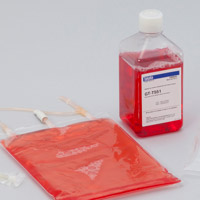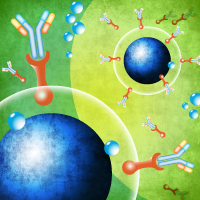RetroNectin reagent

Research using hematopoietic cells and other suspension cells has been limited in part by low efficiency of gene transfer (transduction and transfection) into these cell types. RetroNectin reagent promotes colocalization of lentivirus or retrovirus with target cells to dramatically enhance transduction efficiency. As a consequence, RetroNectin reagent is now the gold standard transduction enhancer for retroviral/lentiviral gene transfer to hematopoietic cells and holds great promise in clinical application, having been used for over 40 clinical trials.
Research using hematopoietic cells and other suspension cells has been limited in part by low efficiency of gene transfer (transduction and transfection) into these cell types. RetroNectin reagent promotes colocalization of lentivirus or retrovirus with target cells to dramatically enhance transduction efficiency. As a consequence, RetroNectin reagent is now the gold standard transduction enhancer for retroviral/lentiviral gene transfer to hematopoietic cells and holds great promise in clinical application, having been used for over 40 clinical trials.
What is RetroNectin reagent?
RetroNectin reagent is a recombinant human fibronectin fragment (rFN-CH-296) that contains three functional domains: the cell-binding domain, the heparin-binding domain, and the CS-1 sequence.
How does RetroNectin reagent work?
RetroNectin enhances lentiviral- and retroviral-mediated gene transduction by aiding the colocalization of target cells and viral particles. Specifically, virus particles bind RetroNectin reagent via interaction with the H-domain, and target cells bind mainly through the interaction of cell surface integrin receptor VLA-5 and VLA-4 with the fibronectin C-domain and CS-1 site, respectively. By facilitating close physical proximity, RetroNectin reagent can enhance viral-mediated gene transfer to target cells expressing integrin receptors VLA-4 and/or VLA-5. VL-4-expressing cells include T cells, B cells, monocytes, NK cells, eosinophils, bone marrow monocytic cells, and lymphoid progenitors. Thymocytes, activated T cells, and mast cells express VLA-5.
RetroNectin reagent can also enhance T-cell expansion (CD8+ cells) in vitro. T-lymphocyte expansion from peripheral blood mononuclear cells (PBMCs) is usually performed in the presence of interleukin-2 (IL-2) and anti-CD3 antibody stimulation. The efficiency of T-cell expansion can be significantly increased in the presence of RetroNectin reagent. Moreover, the T-cell population after expansion in the presence of RetroNectin reagent contains a high proportion of naive T cells.
What is the difference between RetroNectin Pro and RetroNectin reagent?
RetroNectin Pro (Cat. #T101A & T101B) is produced with more stringent manufacturing practices. RetroNectin Pro uses the same protocol and performs the same as RetroNectin reagent (Cat. #T100A & T100B).
FAQs regarding the proper use of RetroNectin GMP grade
- Question: Can I use Takara Bio's RetroNectin GMP grade in clinical trials?
Answer: Researchers are free to use RetroNectin GMP grade (Cat. # T202) for development of research-based clinical trials. Proper regulatory approval is required before using the GMP-grade product in research-based clinical trials since these trials may require special considerations or more stringent manufacturing standards. - Question: Can I use Takara Bio's RetroNectin GMP grade for commercial use?
Answer: Researchers are free to use the product in accordance with the Notice to Purchaser, but commercial use is not allowed under our general Terms and Conditions for purchase of these products. Commercial access to the GMP-grade product may be available through a formal License and Supply Agreement. In all cases, it is the researcher’s responsibility to get approval from the appropriate regulatory authorities for the intended use of these ancillary materials for your application. - Question: Can I use RetroNectin GMP grade for in vivo clinical use?
Answer: No. The product cannot be used for direct in vivo applications. The product is intended for use as an ancillary reagent in a manufacturing process which includes other steps prior to any in vivo application. - Question: Is RetroNectin GMP grade registered in DMF?
Answer: A DMF (18898) was submitted for the liquid format RetroNectin GMP grade on March 15, 2019.
Overview
- Enhanced gene transfer efficiency for retroviral or lentiviral transduction of suspension cells, hematopoietic stem cells, and other hard-to-infect cell types
- Less toxicity than other commonly used transduction enhancers, including polybrene and protamine
- Fully recombinant peptide
- The efficiency of T cell (CD8+) expansion can be significantly increased in the presence of RetroNectin reagent
- RetroNectin GMP grade (Cat # T202), is manufactured and tested in accordance with the following guidelines, "Standards for Manufacturing Control and Quality Control, etc. of Investigational Products (Investigational products GMP)" notified by the Ministry of Health and Welfare Japan ("PFSB Notification No. 0709002, July 9, 2008)" (PFSB: Pharmaceutical and Food Safety Bureau)
- Takara Bio Inc., has submitted a Drug Master File (DMF application number 18898) to the Food and Drug Administration for RetroNectin GMP grade.
More Information
Applications
- Enhanced retroviral or lentiviral mediated transduction of cells that express VLA-4 or VLA-5 (including many hematopoietic cell types)
- In vitro T-cell expansion of CD8+ cells
- RetroNectin reagent has been used in over 40 clinical trials
- Research-grade RetroNectin (Cat. # T100A/B; T110A): For research use only. Not for use in diagnostic or therapeutic procedures.
- GMP-grade RetroNectin (Cat. # T202): Manufactured as a quality-assured product, according to relevant guidelines for Good Manufacturing Practice (GMP). This product can be used for ex vivo clinical applications.
For applications other than research use
- The method of T-cell expansion by RetroNectin stimulation requires a license from Takara Bio Inc. for uses other than research.
- RetroNectin GMP grade can be used for ex vivo clinical applications (investigational use only): For GMP grade, please complete and return this form prior to purchase.
Additional product information
Please see the product's Certificate of Analysis for information about storage conditions, product components, and technical specifications. Please see the Kit Components List to determine kit components. Certificates of Analysis and Kit Components Lists are located under the Documents tab.

FAQs about RetroNectin reagent
What is RetroNectin reagent and how does it work? Which cell types can benefit from RetroNectin-assisted viral transduction? Find answers to your questions and more!
FAQs page Learning center
Scale up transduction of hematopoietic cells with CultiLife culture bags
CultiLife culture bags provide a closed, sterile, gas-permeable system that reduces the risk of culture contamination and user exposure to cell culture materials. A 300-ml format (which can be coated with RetroNectin reagent) is available for high-efficiency viral transduction of hematopoietic cells and a 1,000-ml format can be used to expand cell cultures following transduction. View our protocol and see how to set up your cell culture in a single small bag and then expand it into multiple larger bags.
View protocol and specifications Buy nowTakara Bio USA, Inc.
United States/Canada: +1.800.662.2566 • Asia Pacific: +1.650.919.7300 • Europe: +33.(0)1.3904.6880 • Japan: +81.(0)77.565.6999
FOR RESEARCH USE ONLY. NOT FOR USE IN DIAGNOSTIC PROCEDURES. © 2025 Takara Bio Inc. All Rights Reserved. All trademarks are the property of Takara Bio Inc. or its affiliate(s) in the U.S. and/or other countries or their respective owners. Certain trademarks may not be registered in all jurisdictions. Additional product, intellectual property, and restricted use information is available at takarabio.com.






